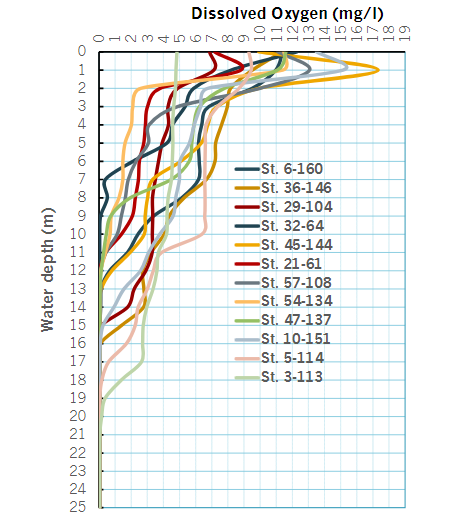Dissolved Oxygen Profiles and Its Problems at Lake Maninjau, West Sumatra – Indonesia
DOI:
https://doi.org/10.51264/inajl.v1i1.3Keywords:
Batang Antokan River, dissolved oxygen profile, Lake Maninjau, water qualityAbstract
In general, the tropical lake in Indonesia is one of the unique ecosystems which are functioning in both ecological and economic services. This study aims to analyze the dissolved oxygen profile of caldera tropical lake represented by Lake Maninjau at West Sumatera, Indonesia, and its impacts. Lake Maninjau is not only for culture fisheries but also serves as important hydroelectricity power. Surveys at Lake Maninjau were conducted in August 2006, March 2014, September 2017, and April 2018. The results showed that the average depth is 105 m. It covers 13,260 ha of an area with an elevation of 461.5 m above sea level and a maximum depth of 165 m. The lake water comes from rainfall, small rivers, and the surrounding groundwater, with one outflow in the Batang Antokan River. Based on the measurement, it was observed that decreasing dissolved oxygen levels occurred at the surface to the depth of 40 m in 2006, and changed from surface to a depth of 12 m in 2018 indicating the worse condition of water quality compared with the previous years. Recently, bad water quality with mass mortality of cultured fish often occurs. Next, the percentage of fish cages area at Lake Maninjau in 2017 was 0.43%. Besides human activities, it was suggested that fish cages also contributed pollutant load to this lake. To maintain the sustainability of the lake, basic ecological information is necessary for the next study.
References
Agam Regency. 2018. Save Maninjau. Presentation of Agam Regency on JSPS Workshop, Tsukuba – March.
Direktur Jenderal Perikanan Budidaya,Kementerian Kelautan dan Perikanan. 2014. Kebijakan pengelolaan perikanan buidaya di perairan umum daratan. Seminar Nasional Limnologi VII, LIPI, Cibinong, Bogor.
Fakhrudin M, Subehi L, Jasalesmana T, and Dianto A. 2019. Dissolved oxygen and temperature stratification analysis for early warning system development to prevent mass mortality fish in Lake Maninjau, West Sumatera – Indonesia. IOP Conf. Series: Earth and Environmental Science 2019 November, 380(1), 012002. DOI: 10.1088/1755-1315/380/1/012002.
Fakhrudin M, Wibowo H, Subehi L, and Ridwansyah I. 2002. Karakterisasi Hidrologi Danau Maninjau Sumatera Barat. Prosiding Seminar Nasional Limnologi 2002. Pusat Penelitian Limnologi – LIPI, 65 – 75.
Fukushima T, Matsushita B, Subehi L, Setiawan F, and Wibowo H. 2017. Will hypolimnetic waters become anoxic in all deep tropical lakes? Nature; Scientific Reports, 7, 45320. DOI: 10.1038/srep45320Sci. Rep. 7, 45320, 1 – 8.
Research Center for Limnology. 2001. Permasalahan Danau Maninjau dan Pendekatan Penyelesaiannya. Kerjasama Antara Proyek Pengembangan dan Peningkatan Kemampuan Teknologi dengan Puslit Limnologi LIPI, Cibinong-Bogor.
Santoso & Batu UML. 2007. Morfogenesis daerah danau kaldera Maninjau, Sumatera Barat. Jurnal Sumber Daya Geologi, XVII(2), 91-104.
Subehi L, Siti Norasikin Ismail, Ridwansyah I, Muzzalifah Abd Hamid, and Mashhor Mansor. 2018. Analysis of the influence of reservoirs utilization to water quality profiles in Indonesia (Saguling – Jatiluhur) and Malaysia (Temengor – Chenderoh) with special references to cascade reservoirs. IOP Conf. Series: Earth and Environmental Science, 118(1), 012025. DOI: 10.1088/1755-1315/118/1/012025.







